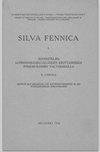Geographic variations of wood properties of Larix sibirica naturally grown in Mongolia
IF 1.7
3区 农林科学
Q2 FORESTRY
引用次数: 10
Abstract
Geographic variations in growth, stress-wave velocity of stem, dynamic Young’s modulus of stems and logs, annual ring width, latewood percentage and basic density were investigated for Larix sibirica (Münchh.) Ledeb. naturally grown in Mongolia. A total of 250 trees with 20 to 30 cm in stem diameter at a height of 1.3 m above ground level were selected from each natural stand in five different provenances in Mongolia. In addition, five trees in each stand were cut for measuring dynamic Young’s modulus of stems and logs, annual ring width, latewood percentage and basic density. Mean values of stress-wave velocity of stems in each stand ranged from 2.92 to 3.41 km s–1, and the mean value of five stands was 3.23 km s–1. Mean values of dynamic Young’s modulus of logs in each stand ranged from 5.17 to 9.72 GPa. A significant correlation (r = 0.798, p < 0.01) was found between stress-wave velocity of stems and dynamic Young’s modulus of logs. Among the five stands, the highest and the lowest values of average annual ring number were 193 and 44, respectively. Mean values of basic density in five trees within each stand were examined and ranged from 0.52 to 0.56 g cm–3. Significant differences among five stands were found in tree height, stress-wave velocity of stem, dynamic Young’s modulus of stems and logs, annual ring width and latewood percentage, suggesting that L. sibirica trees naturally grown in Mongolia have geographic variations in mechanical properties of wood.蒙古天然落叶松木材特性的地理变异
研究了西伯利亚落叶松(Larix sibirica, m nchh)生长、茎应力波速度、茎和原木动态杨氏模量、年轮宽度、迟木率和基本密度的地理差异。Ledeb。自然生长在蒙古。在蒙古5个不同种源的每个自然林分中,选取茎粗为20 ~ 30 cm、离地高度为1.3 m的树木250棵。此外,每个林分采伐5棵树,测量树干和原木的动态杨氏模量、年轮宽度、后期木材百分比和基本密度。各林分茎秆应力波速度平均值为2.92 ~ 3.41 km s-1, 5个林分的平均值为3.23 km s-1。各林分原木动态杨氏模量平均值在5.17 ~ 9.72 GPa之间。树干应力波速度与原木动态杨氏模量呈极显著相关(r = 0.798, p < 0.01)。5个林分的年平均年轮数最高为193个,最低为44个。每个林分内5棵树的基本密度平均值为0.52 ~ 0.56 g cm-3。5个林分在树高、树干应力波速度、树干和原木动态杨氏模量、年轮宽度和晚材率等指标上存在显著差异,表明蒙古天然生长的西伯利亚松林在木材力学性能上存在地理差异。
本文章由计算机程序翻译,如有差异,请以英文原文为准。
求助全文
约1分钟内获得全文
求助全文
来源期刊

Silva Fennica
农林科学-林学
CiteScore
3.50
自引率
11.10%
发文量
21
审稿时长
3 months
期刊介绍:
Silva Fennica publishes significant new knowledge on forest sciences. The scope covers research on forestry and forest ecosystems. Silva Fennica aims to increase understanding on forest ecosystems, and sustainable use and conservation of forest resources. Use of forest resources includes all aspects of forestry containing biomass-based and non-timber products, economic and social factors etc.
 求助内容:
求助内容: 应助结果提醒方式:
应助结果提醒方式:


